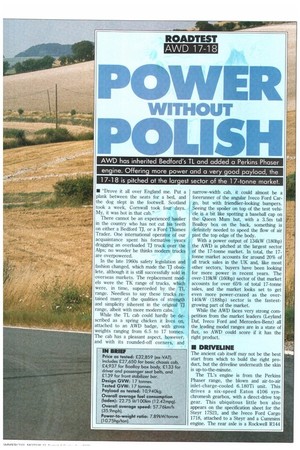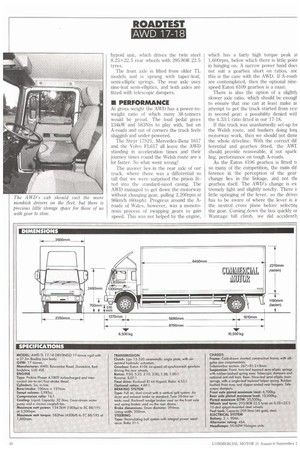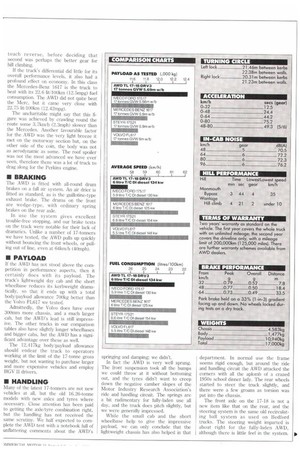P9,1 1 111 . 1 ing
Page 31

Page 32

Page 33

If you've noticed an error in this article please click here to report it so we can fix it.
IPCOL SHI
• "Drove it all over England me. Put a plank between the seats for a bed, and the dog slept in the footwell. Scotland took a week, Cornwall took four days. My, it was hot in that cab."
There cannot be an experienced haulier in the country who has not cut his. teeth on either a Bedford TJ, or a Ford Thames Trader. One international operator of our acquaintance spent his formative years dragging an overloaded TJ truck over the Alps; no wonder he thinks modern trucks are overpowered.
In the late 1960s safety legislation and fashion changed, which made the Ti obsolete, although it is still successfully sold is overseas markets. The replacement models were the TK range of trucks, which were, in time, superceded by the TL range. Needless to say these trucks retained many of the qualities of strength and simplicity inherent in the original TJ range, albeit with more modern cabs.
While the TL cab could hardly be described as a spring chicken it lives on, attached to an AWD badge, with gross weights ranging from 6.5 to 17 tonnes. The cab has a pleasant aspect, however, and with its rounded-off corners, and narrow-width cab, it could almost be a forerunner of the angular Iveco Ford Cargo, but with friendlier-looking bumpers. Seeing the spoiler on top of the test vehicle is a bit like spotting a baseball cap on the Queen Mum but, with a 3.5m tall Boalloy box on the back, something is definitely needed to speed the flow of air past the top edge of the body.
With a power output of 134kW (180hp) the AWD is pitched at the largest sector of the 17-tonne market. In total, the 17tonne market accounts for around 20% of all truck sales in the UK and, like most other sectors, buyers have been looking for more power in recent years. The over-119kW (160hp) sector of that market accounts for over 65% of total 17-tonne sales, and the market looks set to get even more power-crazed as the over140kW (188hp) sector is the fastestgrowing part of the market.
While the AWD faces very strong competition from the market leaders (Leyland Daf, Iveco Ford and Mercedes-Benz) all the leading model ranges are in a state of flux, so AWL) could score if it has the right product.
The ancient cab itself may not be the best
• DRIVELINE Nog
The ancient cab itself may not be the best start from which to build the right product, but the driveline underneath the skin is up-to-the-minute.
The IL's engine is from the Perkins Phaser range, the blown and air-to-air inlet-charge-cooled 6.180Ti unit. This drives a six-speed Eaton 4106 synchromesh gearbox, with a direct-drive top gear. This ubiquitous little box also appears on the specification sheet for the Steyr 17S21, and the Iveco Ford Cargo 1718, attached to a Steyr and a Cummins engine. The rear axle is a Rockwell R144 hypoid unit, which drives the twin steel 8.25x22.5 rear wheels with 295/80R 22.5 tyres.
The front axle is lifted from older TL models and is sprung with taper-leaf, semi-elliptic springs. The rear axle uses nine-leaf semi-elliptics, and both axles are fitted with telescopic dampers.
• PERFORMANCE
At gross weight the AWE) has a power-toweight ratio of which many 38-tonners would be proud. The loud pedal gives 134kW and 583Nm to play with, but on A-roads and out of corners the truck feels sluggish and under-powered.
The Steyr 17S21, Mercedes-Benz 1617 and the Volvo FL617 all leave the AWD standing in acceleration times and their journey times round the Welsh route are a lot faster. So what went wrong?
The answer lies in the rear axle of our truck, where there was a differential so tall that we were surprised the pinion fitted into the standard-sized casing. The AWD managed to get down the motorway without changing 'gear, pulling 2,200rpm at 96km/h (60mph). Progress around the A-. roads of Wales, however, was a monotonous process of swapping gears to gain speed. This was not helped by the engine, which has a fairly high torque peak al 1,600rpm, below which there is little poini in hanging on. A narrow power band doe( not suit a gearbox short on ratios, anc this is the case with the AWL). if A-roady are contemplated, then the optional nine. speed Eaton 6109 gearbox is a must.
There is also the option of a slightl) slower axle ratio, which should be enougt to ensure that one can at least make ar attempt to get the truck started from resi in second gear; a possibility denied witt the 4.33:1 ratio fitted in our 17-18.
If this truck was unashamedly set-up foi the Welsh route, and hauliers doing loni motorway work, then we should not claiou the whole driveline. With the correct dif ferential and gearbox fitted, the AWE should provide reasonable, if not spark. hog, performance on tough A-roads.
As the Eaton 4106 gearbox is fitted t( so many of the competition, the main dif ference in the perception of the gear change lies in the linkage, and not th( gearbox itself. The AWD's change is ex tremely light and slightly notchy. There it little springing of the lever, so the drivel has to be aware of where the lever is it the neutral cross plane before selectinr the gear. Coming down the box quickly or Wantage hill climb, we did accidenth
touch reverse, before deciding that second was perhaps the better gear for hill climbing.
If the truck's differential did little for its overall performance levels, it also had a profound effect on economy. In this class the Mercedes-Benz 1617 is the truck to beat with its 22.6 liti100km (12.5mpg) fuel consumption. The AWD did not quite beat the Merc, but it came very close with 22.75 lit./100km (12.42mpg).
The uncharitable might say that this figure was achieved by crawling round the route some 3.7kmih (2.3mph) slower than the Mercedes. Another favourable factor for the AWD was the very light breeze it met on the motorway section but, on the other side of the coin, the body was not as aerodynamic as some. The roof spoiler was not the most advanced we have ever seen, therefore there was a lot of truck to drag along for the Perkins engine.
• BRAKING The AWD is fitted with all-round drum brakes on a full air system. An air drier is fitted as standard, as is the guillotine-type exhaust brake. The drums on the front are wedge-type, with ordinary spring brakes on the rear axle.
In use the system gives excellent trouble-free stopping, and our brake tests on the track were notable for their lack of dramatics. Unlike a number of 17-tonners we have tested, the AWD pulls up quickly without bouncing the front wheels, or pulling out of line, even at 64kmili (40mph).
• PAYLOAD If the AWD has not stood above the competition in performance aspects, then it certainly does with its payload. The truck's lightweight day cab and the short wheelbase reduces its kerbweight dramatically, so that it ends up with a total body/payload allowance 700kg better than the Volvo FL617 we tested.
Admittedly, the Volvo does have over 300mm more chassis, and a much larger cab, but the AVM's lead is still impressive. The other trucks in our comparison tables also have slightly longer wheelbases and bigger cabs, but the AWD has a significant advantage over these as well.
The I2,417kg body/payload allowance should endear the truck to operators working at the limit of the 17-tonne gross weight, but not wanting to purchase larger and more expensive vehicles and employ FIGV 11 drivers.
• HANDLING
Many of the latest 17-tonners are not new vehicles at all, but the old 16.26-tonne models with new axles and tyres where necessary. Close attention has been paid to getting the axle/tyre combination right, but the handling has not received the same scrutiny. We half expected to complete the AWL) test with a notebook full of unflattering comments about the AWD's springing and damping; we didn't.
In fact the AWD is very well sprung. The front suspension took all the bumps we could throw at it without bottoming out, and the tyres didn't want to creep down the negative camber slopes of the Motor Industry Research Association's ride and handling circuit. The springs are a bit rudimentary for fully-laden use all day, and the truck does pitch slightly, but we were generally impressed.
While the small cab and the short wheelbase help to give the impressive payload, we can only conclude that the lightweight chassis has also helped in that department. In normal use the frame seems rigid enough, but around the ride and handling circuit the AWD attacked the corners with all the aplomb of a crazed 1950s school dinner lady. The rear wheels started to steer the truck slightly, and there were a few groans as torsion was put into the chassis.
The front axle on the 17-18 is not a new item like that on the rear, and the steering system is the same old recirculating ball system as used on Bedford trucks. The steering weight imparted is about right for the fully-laden AWD, although there is little feel in the system.
































































































































